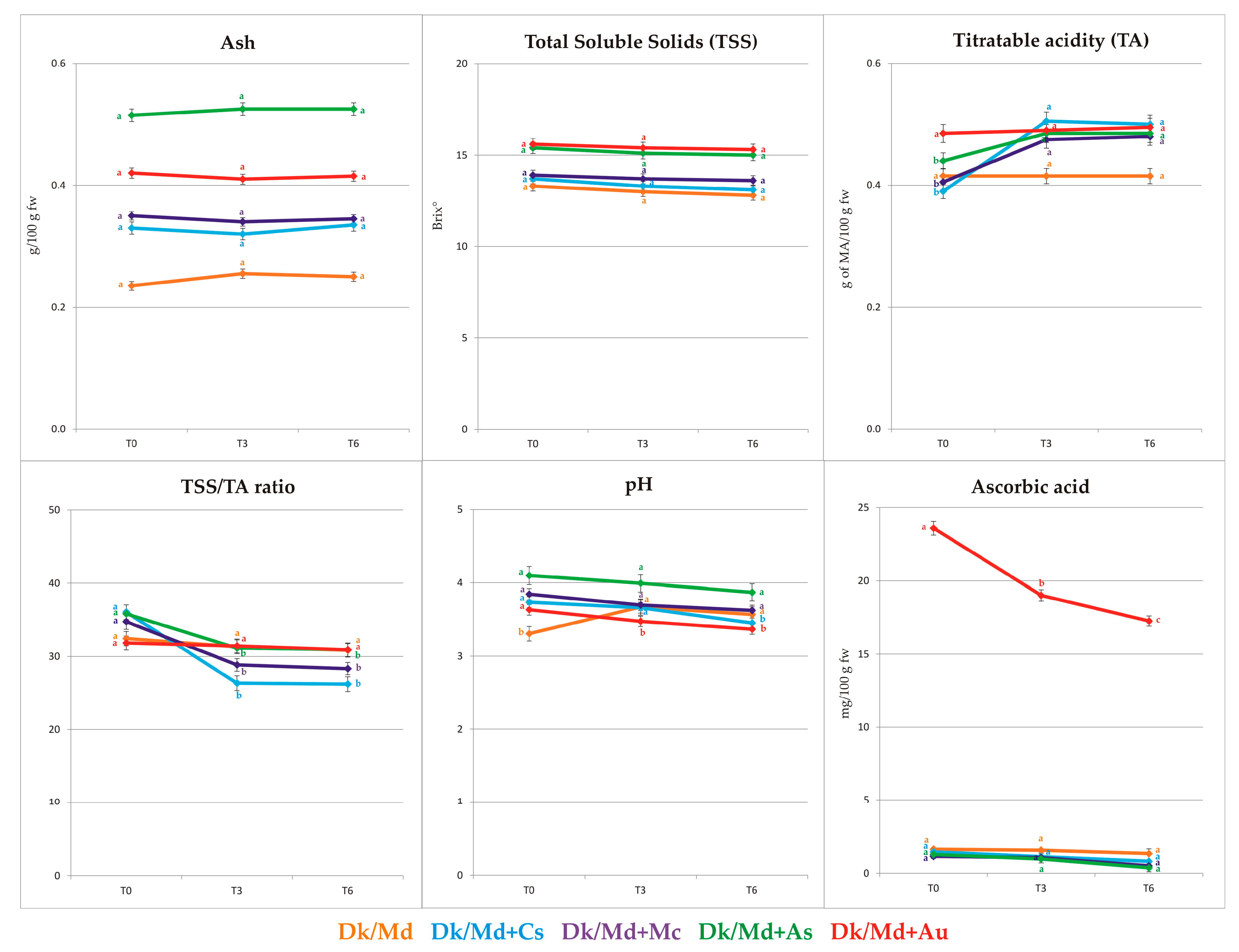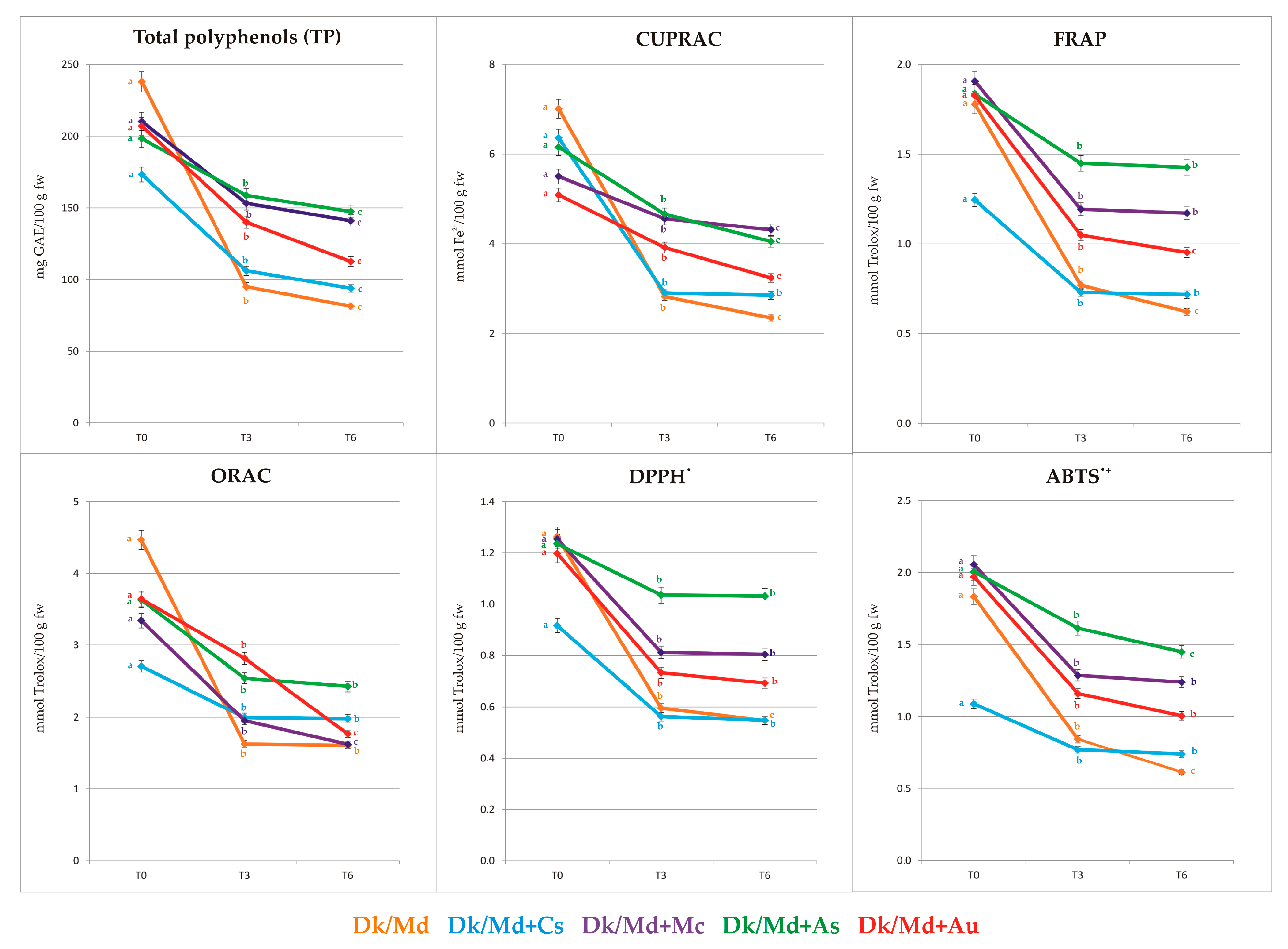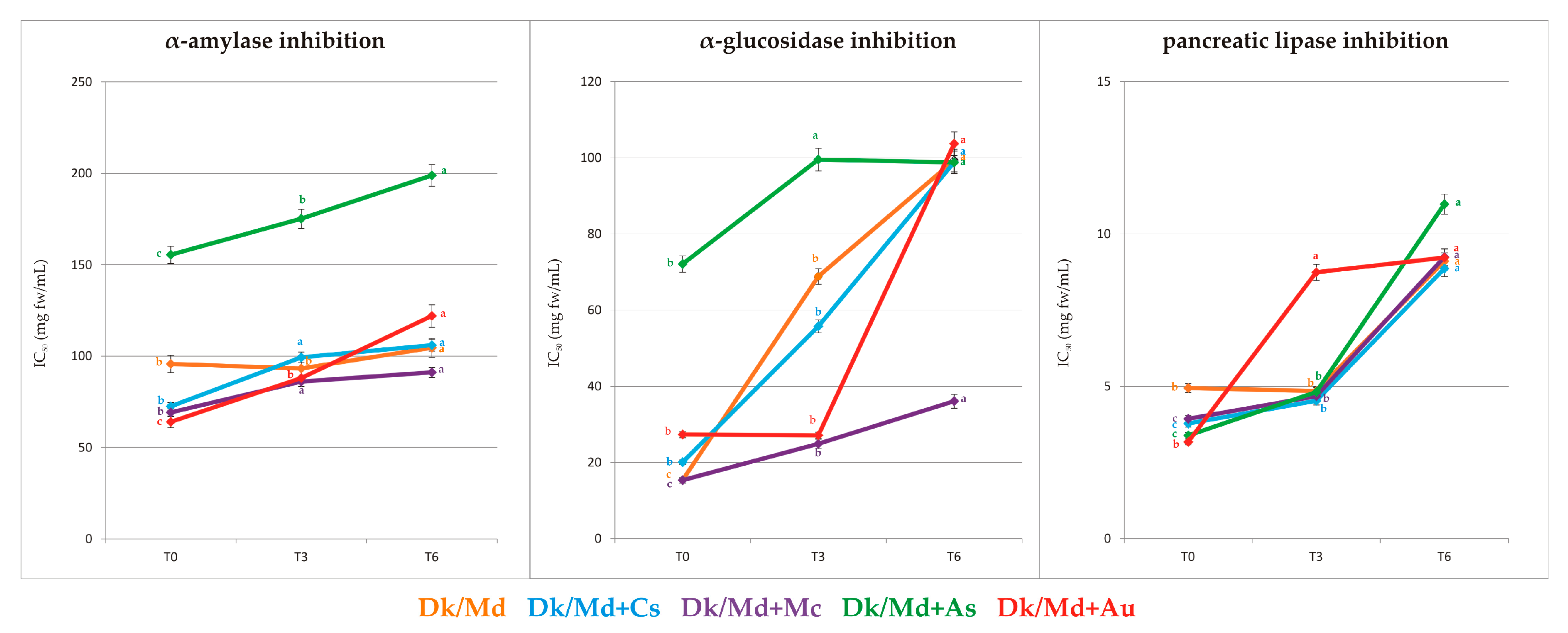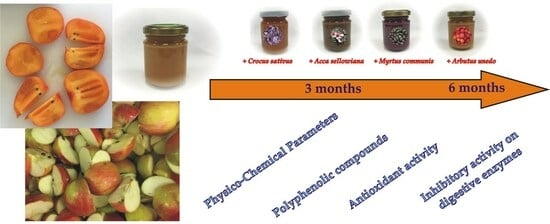Investigation into Polyphenol Profile and Biological Activities of Enriched Persimmon/Apple Smoothies during Storage
Abstract
:1. Introduction
2. Materials and Methods
2.1. Chemicals and Standards
2.2. Plant Materials and Persimmon/Apple Smoothies Production
2.3. Sensory Evaluation of Smoothies
2.4. Determination of the Physico-Chemical Parameters in Obtained Smoothies
2.5. Determination of Polyphenolic Compounds in Persimmon/Apple Smoothies
2.6. Determination of Total Phenolic Content, Total Reducing Power, Free Radical Scavenging Activity, and Digestive Enzymes Inhibition Assays
2.7. Statistical Analysis
3. Results and Discussion
3.1. Sensory Evaluation of Smoothies
3.2. Determination of the Physico-Chemical Parameters
3.3. Identification and Quantification of Polyphenolic Compounds and Analysis of Polymeric Proanthocyanidins by Phloroglucinol Method
3.4. Determination of Total Phenolic Content, Total Reducing Power, and Free Radical Scavenging Activity
3.5. Digestive Enzymes Inhibition Assays of Obtained Products before and after Storage
4. Conclusions
Supplementary Materials
Author Contributions
Funding
Data Availability Statement
Acknowledgments
Conflicts of Interest
References
- Daood, H.G.; Biacs, P.; Czinkotai, B.; Hoschke, Á. Chromatographic investigation of carotenoids, sugars, and organic acids form Diospyros kaki fruits. Food Chem. 1992, 45, 151–155. [Google Scholar] [CrossRef]
- Celik, A.; Ercisli, S. Persimmon cv. Hachiya (Diospyros kaki Thunb.) fruit: Some physical, chemical and nutritional properties. Int. J. Food Sci. 2009, 59, 599–606. [Google Scholar] [CrossRef] [PubMed]
- Bibi, N.; Khattak, A.B.; Mehmood, Z. Quality improvement and shelf life extension of persimmon fruit (Diospyros kaki). J. Food Eng. 2007, 79, 1359–1363. [Google Scholar] [CrossRef]
- Mir-Marqués, A.; Domingo, A.; Cervera, M.L.; De la Guardia, M. Mineral profile of kaki fruits (Diospyros kaki L.). Food Chem. 2015, 172, 291–297. [Google Scholar] [CrossRef]
- Butt, M.S.; Sultan, M.T.; Aziz, M.; Naz, A.; Ahmed, W.; Kumar, N.; Imran, M. Persimmon (Diospyros kaki) fruit: Hidden phytochemicals and health claims. EXCLI J. 2015, 4, 542–561. [Google Scholar] [CrossRef]
- Akter, M.S.; Ahmed, M.; Eun, J.B. Dietary fibre components, antioxidant activities and hydration properties of ripe persimmon (Diospyros kaki L. cv. Daebong) peel powders as affected by different washing treatments. Int. J. Food Sci. Technol. 2010, 45, 1464–1471. [Google Scholar] [CrossRef]
- Pu, F.; Ren, X.L.; Zhang, X.P. Phenolic compounds and antioxidant activity in fruits of six Diospyros kaki genotypes. Eur. Food Res. Technol. 2013, 237, 923–932. [Google Scholar] [CrossRef]
- Choudhary, R.; Singh, A.; Upadhyay, A.; Singh, R.; Thangalakshmi, S.; Dar, A.H.; Bajpai, V.K.; Shukla, S. Exotic god fruit, persimmon (Diospyros kaki): Pharmacological importance and human health aspects. eFood 2022, 4, e52. [Google Scholar] [CrossRef]
- Lee, Y.A.; Cho, E.J.; Yokozawa, T. Protective effect of persimmon (Diospyros kaki) peel proanthocyanidin against oxidative damage under H2O2-induced cellular senescence. Biol. Pharm. Bull. 2008, 31, 1265–1269. [Google Scholar] [CrossRef]
- Matsumura, Y.; Ito, T.; Yano, H.; Kita, E.; Mikasa, K.; Okada, M.; Furutani, A.; Murono, Y.; Shibata, M.; Nishii, Y.; et al. Antioxidant potential in non-extractable fractions of dried persimmon (Diospyros kaki Thunb.). Food Chem. 2016, 202, 99–103. [Google Scholar] [CrossRef]
- Hwang, K.; Hwang, Y.J.; Hwang, I.G.; Song, J.; Cho, S.M. Cholesterol-lowering effect of astringent persimmon fruits (Diospyros kaki Thunb.) extracts. Food Sci. Biotechnol. 2017, 26, 229–235. [Google Scholar] [CrossRef] [PubMed]
- Matheus, J.R.V.; de Andrade, C.J.; Fontanive Miyahira, R.; Cavalcante Fai, A.E. Persimmon (Diospyros kaki L.): Chemical properties, bioactive compounds and potential use in the development of new products—A review. Food Rev. Int. 2022, 38, 384–401. [Google Scholar] [CrossRef]
- Petruzzi, L.; Campaniello, D.; Speranza, B.; Corbo, M.R.; Sinigaglia, M.; Bevilacqua, A. Thermal treatments for fruit and vegetable juices and beverages: A literature overview. Compr. Rev. Food Sci. Food Saf. 2017, 16, 668–691. [Google Scholar] [CrossRef]
- Rodríguez-Roque, M.J.; Ancos, B.D.; Sánchez-Moreno, C.; Cano, M.P.; Elez-Martínez, P.; Martín Belloso, O. Impact of food matrix and processing on the in vitro bioaccessibility of vitamin C, phenolic compounds, and hydrophilic antioxidant activity from fruit juice-based beverages. J. Funct. Foods 2015, 14, 33–43. [Google Scholar] [CrossRef]
- Song, Q.; Li, R.; Song, X.; Clausen, M.P.; Orlien, V.; Giacalone, D. The effect of high-pressure processing on sensory quality and consumer acceptability of fruit juices and smoothies: A review. Food Res. Int. 2022, 157, 111250. [Google Scholar] [CrossRef] [PubMed]
- Škegro, M.; Putnik, P.; Kovačević, D.B.; Kovač, A.P.; Salkić, L.; Čanak, I.; Frece, J.; Zavadlav, S.; Ježek, D. Chemometric comparison of high-pressure processing and thermal pasteurization: The nutritive, sensory, and microbial quality of smoothies. Foods 2021, 10, 1167. [Google Scholar] [CrossRef]
- Casco, M.A.; Jagus, R.J.; Agüero, M.V.; Fernandez, M.V. Ultrasound and its combination with natural antimicrobials: Effects on shelf life and quality stability of a fruit and vegetable smoothie. Food Bioprocess. Technol. 2022, 15, 203–218. [Google Scholar] [CrossRef]
- Kumar, A.; Aggarwal, P.; Kumar, V.; Babbar, N.; Kaur, S. Melon-based smoothies: Process optimization and effect of processing and preservation on the quality attributes. J. Food Meas. Charact. 2022, 16, 4121–4136. [Google Scholar] [CrossRef]
- Wonisch, W.; Stanger, O.; Tatzber, F.; Lindschinger, M.; Murkovic, M.; Cvirn, G. Stability of bioactive components in smoothies within an extended period of one year. Food Biosci. 2022, 49, 101948. [Google Scholar] [CrossRef]
- Bi, X.; Zhou, Z.; Qin, T.; Wang, X.; Ma, Y.; Xing, Y.; Che, Z. Effects of high-pressure processing (HPP) on microorganisms and the quality of mango smoothies during storage. RSC Adv. 2020, 10, 31333–31341. [Google Scholar] [CrossRef]
- Cano-Lamadrid, M.; Hernández, F.; Nowicka, P.; Carbonell-Barrachina, A.A.; Wojdyło, A. Formulation and storage effects on pomegranate smoothie phenolic composition, antioxidant capacity and color. LWT-Food Sci. Technol. 2018, 96, 322–328. [Google Scholar] [CrossRef]
- Gil, K.A.; Wojdyło, A.; Nowicka, P.; Montoro, P.; Tuberoso, C.I.G. Effect of apple juice enrichment with selected plant materials: Focus on bioactive compounds and antioxidant activity. Foods 2023, 12, 105. [Google Scholar] [CrossRef] [PubMed]
- Gil, K.A.; Nowicka, P.; Wojdyło, A.; Serreli, G.; Deiana, M.; Tuberoso, C.I.G. Antioxidant activity and inhibition of digestive enzymes of new strawberry tree fruit/apple smoothies. Antioxidants 2023, 12, 805. [Google Scholar] [CrossRef] [PubMed]
- EN ISO 8589:2009; Sensory Analysis—General Guidelines for the Design of Sensory Analysis Laboratories. ISO: Geneva, Switzerland, 2009.
- Nowicka, P.; Wojdyło, A.; Teleszko, M.; Samoticha, J. Sensory attributes and changes of physicochemical properties during storage of smoothies prepared from selected fruits. LWT-Food Sci. Technol. 2016, 71, 102–109. [Google Scholar] [CrossRef]
- Wojdyło, A.; Nowicka, P.; Oszmiański, J.; Golis, T. Phytochemical compounds and biological effects of Actinidia fruits. J. Funct. Foods 2017, 30, 194–202. [Google Scholar] [CrossRef]
- PN-EN 1135:1999; Fruit and Vegetable Juices. Determination of Ash Content; Polish Committee for Standardization: Warsaw, Poland, 1999.
- PN-EN 12143:2000; Fruit and Vegetable Juices—Determination of Soluble Matter by Refractometric Method. Polish Committee for Standardization: Warsaw, Poland, 2000.
- PN-EN 12147:2000; Fruit and Vegetable Juices—Determination of Titratable Acidity. Polish Committee for Standardization: Warsaw, Poland, 2000.
- PN-A-04019:1998; Food Products—Determination of Vitamin C Content. Polish Committee for Standardization: Warsaw, Poland, 1998.
- Wojdyło, A.; Nowicka, P. Profile of phenolic compounds of Prunus armeniaca L. leaf extract determined by LC-ESI-QTOF-MS/MS and their antioxidant, anti-diabetic, anti-cholinesterase, and anti-inflammatory potency. Antioxidants 2021, 10, 1869. [Google Scholar] [CrossRef]
- Kennedy, J.A.; Jones, G.P. Analysis of proanthocyanidin cleavage products following acid-catalysis in the presence of excess phloroglucinol. J. Agric. Food Chem. 2001, 49, 1740–1746. [Google Scholar] [CrossRef]
- Tuberoso, C.I.G.; Boban, M.; Bifulco, E.; Budimir, D.; Pirisi, F.M. Antioxidant capacity and vasodilatory properties of Mediterranean food: The case of Cannonau wine; myrtle berries liqueur and strawberry-tree honey. Food Chem. 2013, 140, 686–691. [Google Scholar] [CrossRef]
- Bektaşǒglu, B.; Çelik, S.E.; Özyürek, M.; Güçlü, K.; Apak, R. Novel hydroxyl radical scavenging antioxidant activity assay for water-soluble antioxidants using a modified CUPRAC method. Biochem. Biophys. Res. Commun. 2006, 345, 1194–1200. [Google Scholar] [CrossRef]
- Benzie, I.F.F.; Strain, J.J. Ferric reducing ability of plasma (FRAP) as a measure of antioxidant power: The FRAP assay. Anal. Biochem. 1996, 239, 70–76. [Google Scholar] [CrossRef]
- Ou, B.; Huang, D.; Hampsch-Woodill, M.; Flanagan, J.A.; Deemer, E.K. Analysis of antioxidant activities of common vegetables employing oxygen radical absorbance capacity (ORAC) and ferric reducing antioxidant power (FRAP) assay: A comparative study. J. Agric. Food Chem. 2002, 50, 3122–3128. [Google Scholar] [CrossRef]
- Re, R.; Pellegrini, N.; Proteggente, A.; Pannala, A.; Yang, M.; Rice-Evans, C. Antioxidant activity applying an improved ABTS radical cation decolorization assay. Free Radic. Biol. Med. 1999, 26, 1231–1237. [Google Scholar] [CrossRef] [PubMed]
- Worthington Biochemical Corporation. Enzyme Manual, Lakewood, New Jersey 08701. Worthington, Von, Editor, 1947–2009. Worthington, Krystal, editor, 2010–2015. Available online: https://www.worthingtonweb.com/index/manual.html (accessed on 5 February 2023).
- Nowicka, P.; Wojdyło, A.; Samoticha, J. Evaluation of phytochemicals; antioxidant capacity; and antidiabetic activity of novel smoothies from selected Prunus fruits. J. Funct. Foods 2016, 25, 397–407. [Google Scholar] [CrossRef]
- Podsędek, A.; Majewska, I.; Redzynia, M.; Sosnowska, D.; Koziołkiewicz, M. In vitro inhibitory effect on digestive enzymes and antioxidant potential of commonly consumed fruits. J. Agric. Food Chem. 2014, 62, 4610–4617. [Google Scholar] [CrossRef] [PubMed]
- Díaz, L.D.; Dorta, E.; Maher, S.; Morales, P.; Fernández-Ruiz, V.; Cámara, M.; Sánchez-Mata, M. Potential nutrition and health claims in deastringed persimmon fruits (Diospyros kaki L.), variety ‘Rojo brillante’, PDO ’Ribera del xúquer’. Nutrients 2020, 12, 1397. [Google Scholar] [CrossRef] [PubMed]
- Nutrition Society. Scientific concepts of functional foods in Europe—Consensus document. Br. J. Nutr. 1999, 81, S1–S27. [Google Scholar] [CrossRef]
- Nowicka, P.; Wojdyło, A.; Laskowski, P. Principal component analysis (PCA) of physicochemical compounds’ content in different cultivars of peach fruits; including qualification and quantification of sugars and organic acids by HPLC. Eur. Food Res. Technol. 2019, 245, 929–938. [Google Scholar] [CrossRef]
- Nowicka, P.; Wojdyło, A.; Teleszko, M. Effect of mixing different kinds of fruit juice with sour cherry puree on nutritional properties. J. Food Sci. Technol. 2017, 54, 114–129. [Google Scholar] [CrossRef]
- Kheiralipour, K.; Tabatabaeefar, A.; Mobli, H.; Rafiee, S.; Sahraroo, A.; Rajabipour, A.; Jafari, A. Some physical properties of apple. Pak. J. Nutr. 2008, 7, 667–672. [Google Scholar] [CrossRef]
- Zatylny, A.M.; Ziehl, W.D.; St-Pierre, R.G. Physicochemical properties of fruit of chokecherry (Prunus virginiana L.), highbush cranberry (Viburnum trilobum Marsh.), and black currant (Ribes nigrum L.) cultivars grown in Saskatchewan. Can. J. Plant Sci. 2005, 85, 425–429. [Google Scholar] [CrossRef]
- Oliveira, I.; Baptista, P.; Bento, A.; Pereira, J.A. Arbutus unedo L. and its benefits on human health. J. Food Nutr. Res. 2011, 50, 73–85. [Google Scholar]
- Castellanos, D.A.; Polanía, W.; Herreraa, A.O. Development of an equilibrium modified atmosphere packaging (EMAP) for feijoa fruits and modeling firmness and color evolution. Postharvest Biol. Technol. 2016, 120, 193–203. [Google Scholar] [CrossRef]
- Wojdyło, A.; Teleszko, M.; Oszmiański, J. Physicochemical characterisation of quince fruits for industrial use: Yield, turbidity, viscosity and colour properties of juices. Int. J. Food Sci. Technol. 2014, 49, 1818–1824. [Google Scholar] [CrossRef]
- Poll, L. Evaluation of 18 apple varieties for their suitability for juice production. J. Sci. Food Agric. 1981, 32, 1081–1090. [Google Scholar] [CrossRef]
- Jaros, D.; Thamke, I.; Raddatz, H.; Rohm, H. Single-cultivar cloudy juice made from table apples: An attempt to identify the driving force for sensory preference. Eur. Food Res. Technol. 2009, 229, 55–61. [Google Scholar] [CrossRef]
- Morgado, S.; Morgadoa, M.; Plácido, A.I.; Roquec, F.; Duarte, A.P. Arbutus unedo L.: From traditional medicine to potential uses in modern pharmacotherapy. J. Ethnopharmacol. 2018, 225, 90–102. [Google Scholar] [CrossRef]
- Nowicka, P.; Wojdyło, A. Stability of phenolic compounds, antioxidant activity and colour through natural sweeteners addition during storage of sour cherry puree. Food Chem. 2016, 196, 925–934. [Google Scholar] [CrossRef]
- Wojdyło, A.; Figiel, A.; Lech, K.; Nowicka, P.; Oszmiański, J. Effect of convective and vacuum microwave drying on the bioactive compounds, colour, and antioxidant capacity of sour cherries. Food Bioprocess Technol. 2014, 7, 829–841. [Google Scholar] [CrossRef]
- Tkacz, K.; Wojdyło, A.; Nowicka, P.; Turkiewicz, I.; Golis, T. Characterization in vitro potency of biologically active fractions of seeds, skin and flesh from selected Vitis vinifera L. cultivars and interspecific hybrids. J. Funct. Foods 2019, 56, 353–363. [Google Scholar] [CrossRef]
- Unuofin, J.O.; Otunola, G.A.; Afolayan, A.J. In vitro α-amylase, α-glucosidase, lipase inhibitory and cytotoxic activities of tuber extracts of Kedrostis africana (L.) Cogn. Heliyon 2018, 4, e00810. [Google Scholar] [CrossRef]
- Wang, T.; Li, X.; Zhou, B.; Li, H.; Zeng, J.; Gao, W. Anti-diabetic activity in type 2 diabetic mice and α-glucosidase inhibitory, antioxidant and anti-inflammatory potential of chemically profiled pear peel and pulp extracts (Pyrus spp.). J. Funct. Foods 2015, 13, 276–288. [Google Scholar] [CrossRef]
- Giordani, E. The evolution of persimmon cultivation in Italy. Acta Hortic. 2022, 1338, 7–10. [Google Scholar] [CrossRef]





Disclaimer/Publisher’s Note: The statements, opinions and data contained in all publications are solely those of the individual author(s) and contributor(s) and not of MDPI and/or the editor(s). MDPI and/or the editor(s) disclaim responsibility for any injury to people or property resulting from any ideas, methods, instructions or products referred to in the content. |
© 2023 by the authors. Licensee MDPI, Basel, Switzerland. This article is an open access article distributed under the terms and conditions of the Creative Commons Attribution (CC BY) license (https://creativecommons.org/licenses/by/4.0/).
Share and Cite
Gil, K.A.; Nowicka, P.; Wojdyło, A.; Tuberoso, C.I.G. Investigation into Polyphenol Profile and Biological Activities of Enriched Persimmon/Apple Smoothies during Storage. Foods 2023, 12, 3248. https://doi.org/10.3390/foods12173248
Gil KA, Nowicka P, Wojdyło A, Tuberoso CIG. Investigation into Polyphenol Profile and Biological Activities of Enriched Persimmon/Apple Smoothies during Storage. Foods. 2023; 12(17):3248. https://doi.org/10.3390/foods12173248
Chicago/Turabian StyleGil, Katarzyna Angelika, Paulina Nowicka, Aneta Wojdyło, and Carlo Ignazio Giovanni Tuberoso. 2023. "Investigation into Polyphenol Profile and Biological Activities of Enriched Persimmon/Apple Smoothies during Storage" Foods 12, no. 17: 3248. https://doi.org/10.3390/foods12173248
APA StyleGil, K. A., Nowicka, P., Wojdyło, A., & Tuberoso, C. I. G. (2023). Investigation into Polyphenol Profile and Biological Activities of Enriched Persimmon/Apple Smoothies during Storage. Foods, 12(17), 3248. https://doi.org/10.3390/foods12173248












